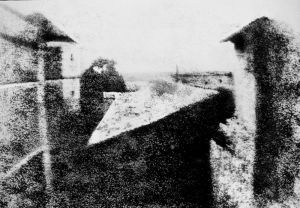The first permanent photograph (later accidentally destroyed) was an image produced in 1826 by the French inventor Joseph Nicéphore Niépce. His photographs were produced on a polished pewter plate covered with a petroleum derivative called bitumen of Judea. Bitumen hardens with exposure to light. The unhardened material may then be washed away and the metal plate polished, rendering a negative image which then may be coated with ink and impressed upon paper, producing a print. Niépce then began experimenting with iron compounds based on a Johann Heinrich Schultz discovery in 1724 that a iron and chalk mixture darkens when exposed to light.
 Nicéphore Niépce’s earliest surviving photograph.
Nicéphore Niépce’s earliest surviving photograph.
In partnership, Niépce (in Chalon-sur-Saône) and Louis Daguerre (in Paris) refined the existing silver process. In 1833 Niépce died of a stroke, leaving his notes to Daguerre. While he had no scientific background, Daguerre made two pivotal contributions to the process. He discovered that exposing the silver first to iodine vapour before exposure to light, and then to mercury fumes after the photograph was taken, could form a latent image. Bathing the plate in a salt bath then fixes the image. On January 7, 1839 Daguerre announced that he had invented a process using silver on a copper plate called the daguerreotype.
 “Boulevard du Temple”, taken by Louis Daguerre in late 1838 or early 1839.
“Boulevard du Temple”, taken by Louis Daguerre in late 1838 or early 1839.
The daguerreotype proved popular in responding to the demand for portraiture emerging from the middle classes during the Industrial Revolution. This demand, that could not be met in volume and in cost by oil painting, added to the push for the development of photography.
In 1847, Count Sergei Lvovich Levitsky designed a bellows camera which significantly improved the process of focusing.
In America, by 1851 a broadside by daguerreotypist Augustus Washington were advertising prices ranging from 50 cents to $10. However, daguerreotypes were fragile and difficult to copy. Photographers encouraged chemists to refine the process of making many copies cheaply, which eventually led them back to Talbot’s process.
Ultimately, the modern photographic process came about from a series of refinements and improvements in the first 20 years. In 1884 George Eastman, of Rochester, New York, developed dry gel on paper, or film, to replace the photographic plate so that a photographer no longer needed to carry boxes of plates and toxic chemicals around. In July 1888 Eastman’s Kodak camera went on the market with the slogan “You press the button, we do the rest”. Now anyone could take a photograph and leave the complex parts of the process to others, and photography became available for the mass-market in 1901 with the introduction of the Kodak Brownie.



Leave a comment